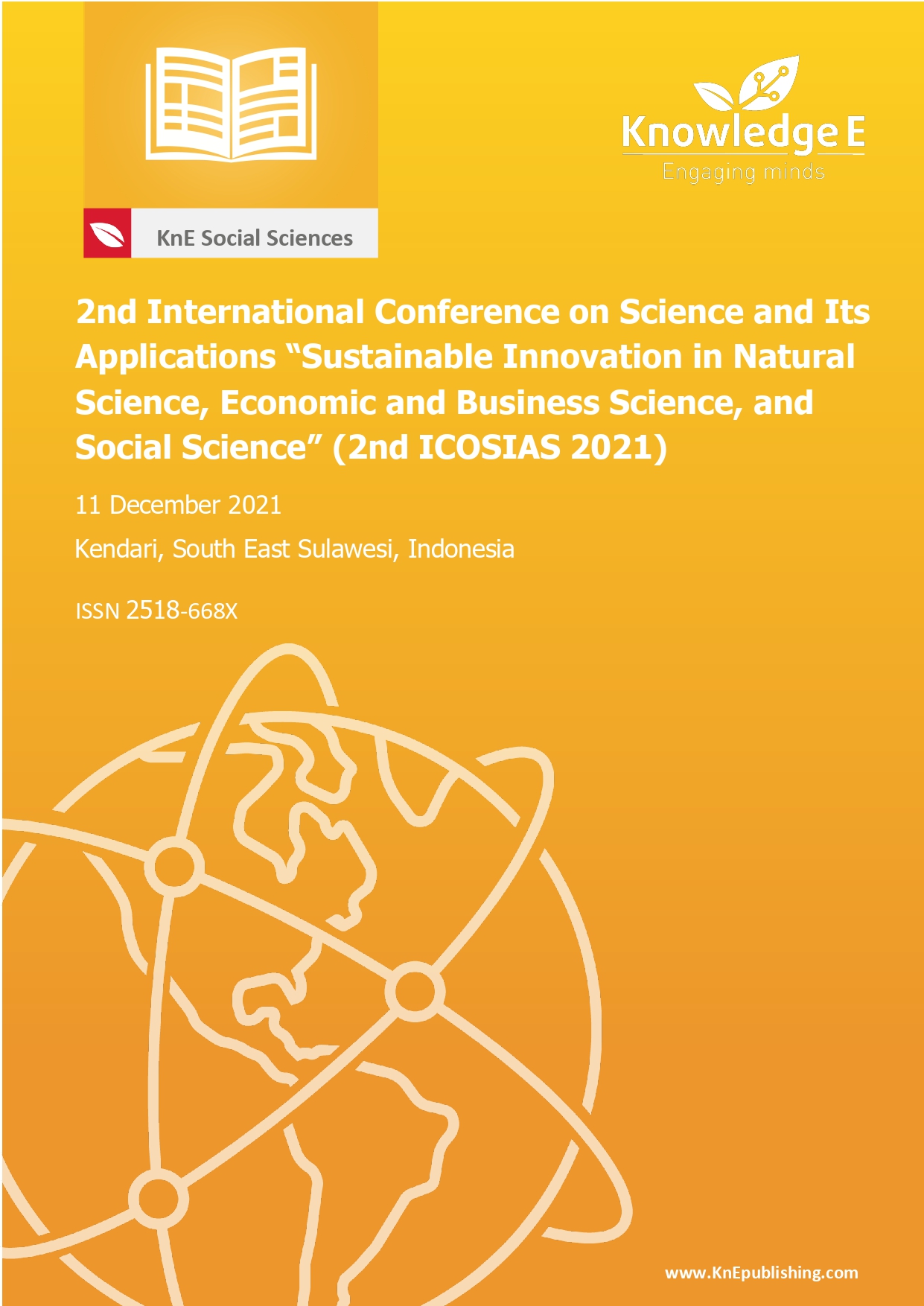How Was Hybrid Learning Conducted for Deaf Students During the COVID-19 Pandemic?(A Case Study in Special School)
DOI:
https://doi.org/10.18502/kss.v8i2.12757Abstract
This study aimed to investigate how hybrid learning was conducted for deaf students during the COVID-19 pandemic. Using qualitative methods, this study had three main results. First, hybrid learning for deaf students was held via WhatsApp. Second, deaf students spent 3-6 hours a day studying at home to practice theoretical subject learning. Third, remote learning saw teachers improving their competencies by joining workshops for helped online learning.
Keywords: Covid-19 Pandemic, Deaf Students, Hybrid Learning, Special School
References
P. Pattisapu et al., “Defining Essential Services for Deaf and Hard of Hearing Children during the COVID-19 Pandemic,” Otolaryngol. - Head Neck Surg. (United States), vol. 163, no. 1, pp. 91–93, 2020, doi: 10.1177/0194599820925058.
A. Madhesh, “Full exclusion during COVID-19: Saudi Deaf education is an example,” Heliyon, vol. 7, no. 3, p. e06536, 2021, doi: 10.1016/j.heliyon.2021.e06536.
L. Zhou, S. Wu, M. Zhou, and F. Li, “’School’s Out, But Class’ On’, The Largest Online Education in the World Today: Taking China’s Practical Exploration During The COVID-19 Epidemic Prevention and Control As an Example,” SSRN Electron. J., 2020, doi: 10.2139/ssrn.3555520.
“Global Education Coalition.” [Online]. Available: https://en.unesco.org/covid19/educationresp [Accessed: 30 Nov-2021].
A. A. Alshawabkeh, M. L. Woolsey, and F. F. Kharbat, “Using online information technology for deaf students during COVID-19: A closer look from experience,”Heliyon, vol. 7, no. 5, p. e06915, 2021, doi: 10.1016/j.heliyon.2021.e06915.
F. Reimers, A. Schleicher, J. Saavedra, and S. Tuominen, “Supporting the continuation of teaching and learning during the COVID-19 pandemic,” pp. 1–38, 2020.
C. Carrillo and M. A. Flores, “COVID-19 and teacher education: a literature review of online teaching and learning practices,” Eur. J. Teach. Educ., vol. 43, no. 4, pp. 466–487, 2020, doi: 10.1080/02619768.2020.1821184.
A. Abidah, H. N. Hidaayatullaah, R. M. Simamora, D. Fehabutar, and L. Mutakinati, “The Impact of Covid-19 to Indonesian Education and Its Relation to the Philosophy of ‘Merdeka Belajar,”’ Stud. Philos. Sci. Educ., vol. 1, no. 1, pp. 38–49, 2020, doi: 10.46627/sipose.v1i1.9.
E. Alsadoon, “Virtual Classrooms for Hearing- impaired Students during the COVID- 19 Pandemic,” Rev. Rom. pentru Educ. Multidimens., vol. 12, no. 1, pp. 1–8, 2020.
M. A. Pappas et al., “E-learning for deaf adults from a user-centered perspective,” Educ. Sci., vol. 8, no. 4, 2018, doi: 10.3390/educsci8040206.
L. Nusser, “Learning at home during COVID-19 school closures–How do German students with and without special educational needs manage?,” Eur. J. Spec. Needs Educ., vol. 36, no. 1, pp. 51–64, 2021, doi: 10.1080/08856257.2021.1872845.
K. Ames, L. R. Harris, J. Dargusch, and C. Bloomfield, “‘So you can make it fast or make it up’: K–12 teachers’ perspectives on technology’s affordances and constraints when supporting distance education learning,” Aust. Educ. Res., vol. 48, no. 2, pp. 359–376, 2021, doi: 10.1007/s13384-020-00395-8.
B. N. Bunga, R. P. C. Wijaya, and I. Y. Kiling, “Studying at Home: Experi- ence of Parents and Their Young Children in an Underdeveloped Area of Indonesia,” https://doi.org/10.1080/02568543.2021.1977436, pp. 1–11, Oct. 2021, doi: 10.1080/02568543.2021.1977436.
F. Baroni and M. Lazzari, “Remote teaching for deaf pupils during the COVID- 19 emergency,” Proc. 14th IADIS Int. Conf. e-Learning 2020, EL 2020 - Part 14th Multi Conf. Comput. Sci. Inf. Syst. MCCSIS 2020, pp. 170–174 2020, doi: 10.33965/el2020_202007c024.
C. McKeown and J. McKeown, “Accessibility in Online Courses: Understanding the Deaf Learner,” TechTrends, vol. 63, no. 5, pp. 506–513, 2019, doi: 10.1007/s11528- 019-00385-3.
M. F. Rice and R. A. Carter, “‘When we talk about compliance, it’s because we lived it’ online educators’ roles in supporting students with disabilities,” Online Learn. J., vol. 19, no. 5, 2015, doi: 10.24059/olj.v19i5.581.
P. Ananga, “Pedagogical Considerations of E-Learning in Education for Development in the Face of COVID 19,” Int. J. Technol. Educ. Sci., vol. 4, no. 4, pp. 310–321, 2020, doi: 10.46328/ijtes.v4i4.123.
N. Karasel Ayda, M. Bastas, F. Altinay, Z. Altinay, and G. Dagli, “Distance Education for Students with Special Needs in Primary Schools in the Period of CoVid-19 Epidemic,” Propósitos y Represent., vol. 8, no. 3, 2020, doi: 10.20511/pyr2020.v8n3.587.
D. J. Clandinin, Handbook of narrative inquiry: mapping a methodology. London: Sage publications, 2007.
G. Zhu, M. Rice, H. Rivera, J. Mena, and A. Van Der Want, “‘I did not feel any passion for my teaching’: a narrative inquiry of beginning teacher attrition in China,” Cambridge J. Educ., vol. 50, no. 6, pp. 771–791, 2020, doi: 10.1080/0305764X.2020.1773763.
N. Berasategi Sancho, N. Idoiaga Mondragon, M. Dosil Santamaria, and M. Picaza Gorrotxategi, “The well being of children with special needs during the COVID-19 lockdown: academic, emotional, social and physical aspects,” Eur. J. Spec. Needs Educ., vol. 00, no. 00, pp. 1–14, 2021, doi: 10.1080/08856257.2021.1949093.
D. S. Niederhauser, “Learning from Technology or Learning with Technology,” Nat. Technol., no. 1980, pp. 249–267, 2013, doi: 10.1007/978-94-6209-269-3_14.
R. Huang, J. M. Spector, and J. Yang, Educational technology: a primer for the 21st century. Springer Singapore, 2019.
L. E. Kathryn, “Editorial,” Fundam. Hybrid Teach. Learn., no. 119, pp. 11–18.7, 2017, doi: 10.1002/tl.

